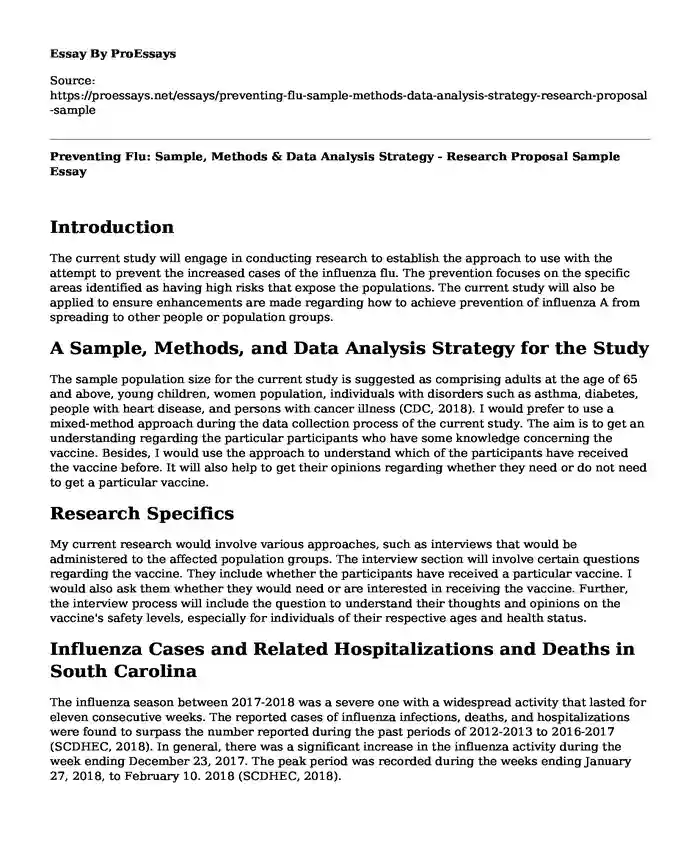Introduction
The current study will engage in conducting research to establish the approach to use with the attempt to prevent the increased cases of the influenza flu. The prevention focuses on the specific areas identified as having high risks that expose the populations. The current study will also be applied to ensure enhancements are made regarding how to achieve prevention of influenza A from spreading to other people or population groups.
A Sample, Methods, and Data Analysis Strategy for the Study
The sample population size for the current study is suggested as comprising adults at the age of 65 and above, young children, women population, individuals with disorders such as asthma, diabetes, people with heart disease, and persons with cancer illness (CDC, 2018). I would prefer to use a mixed-method approach during the data collection process of the current study. The aim is to get an understanding regarding the particular participants who have some knowledge concerning the vaccine. Besides, I would use the approach to understand which of the participants have received the vaccine before. It will also help to get their opinions regarding whether they need or do not need to get a particular vaccine.
Research Specifics
My current research would involve various approaches, such as interviews that would be administered to the affected population groups. The interview section will involve certain questions regarding the vaccine. They include whether the participants have received a particular vaccine. I would also ask them whether they would need or are interested in receiving the vaccine. Further, the interview process will include the question to understand their thoughts and opinions on the vaccine's safety levels, especially for individuals of their respective ages and health status.
Influenza Cases and Related Hospitalizations and Deaths in South Carolina
The influenza season between 2017-2018 was a severe one with a widespread activity that lasted for eleven consecutive weeks. The reported cases of influenza infections, deaths, and hospitalizations were found to surpass the number reported during the past periods of 2012-2013 to 2016-2017 (SCDHEC, 2018). In general, there was a significant increase in the influenza activity during the week ending December 23, 2017. The peak period was recorded during the weeks ending January 27, 2018, to February 10. 2018 (SCDHEC, 2018).
The circulating influenza viruses reported cases were 67.5% (influenza A) and 32.5% (influenza B). the most frequently reported subtype was influenzas A(H3), whereas influenzas B Yamagata was highly reported among the influenza B viruses (SCDHEC, 2018). The total number of la confirmed tests were 3575 positive cases. Besides, there were 131570 positive rapid antigen detection tests recorded during the same period.
Outpatient visits percentage associated with influenza-like diseases was found to be above the state baseline of 3.13% for eighteen consecutive weeks. An intensity of 14.6% was observed during the peak week that ended February 10 (SCDHEC, 2018). The number of influenza hospitalizations rates across the state and influenza-associated mortality rate during the 2017-2018 period was reported as 90.5 and 5.8 per 100000, respectively(SCDHEC, 2018). People at the age of 65 and above were reported to mostly get afflicted during the season. They accounted for 57% of overall influenza-associated hospitalization cases. Besides, they accounted for 72% of the overall influenzas associated deaths (SCDHEC, 2018). Generally, the total number of hospitalizations and deaths in South Carolina was reported as 4489 and 289, respectively.
Data Analysis by Geographical Area
The majority of the countries typically report irregular activity of influenza. It is also established that certain states do not record any influenza activity.
Data Analysis by Demographics
The highest rate of hospitalization is reported among the individuals at the age of 65 and above, representing 460.8 per 100000. The population is followed by adults aged 50-64, representing 115.7 per 100000, while the young children between 0-4 years take third position representing 74.5 per 100000. In the majority of seasons, people at the age of 65 and above record the highest rates of hospitalization. Children between the age of 0-4 follow (CDC, 2018).
Key Flu Indicators and Their Prevalence in South Carolina
In South Carolina, the key indicators of influenza include congestion, cough, nausea, vomiting, high fever, and diarrhea issues.
Conclusion
I would recommend that future location of clinics across South Carolina to focus on places where there is the highest number of people at the age of 65 and above. Clinics should also be located in places where there are children, especially between 0-4 years. Further, I would recommend that the clinics be put in place mainly during the peak periods or months before the start of the flu season.
References
CDC. (2018). Weekly US Map: Influenza Summary Update.
https://www.cdc.gov/flu/weekly/usmap.htm
South Carolina department of Health and Environmental Control (SCDHEC). (2018). South Carolina 2017-18 Influenza End of Season Report and Surveillance Summary. https://www.scdhec.gov/sites/default/files/media/document/SC_2017-18_End_of_Season_Flu_Report.pdf.
Cite this page
Preventing Flu: Sample, Methods & Data Analysis Strategy - Research Proposal Sample. (2023, Nov 16). Retrieved from https://proessays.net/essays/preventing-flu-sample-methods-data-analysis-strategy-research-proposal-sample
If you are the original author of this essay and no longer wish to have it published on the ProEssays website, please click below to request its removal:
- Essay Sample on Nursing Research: Improving Care Quality & Influencing Policies
- Essay on COVID-19 Travel Restrictions: US Defense Secretary Implements Changes
- Essay Sample on Protecting Health Data: The HIPAA Policy
- Essay Example on Sustainable Medical Waste Management: Cost and Benefits
- Essay Example on Two-Party Voting: Divide & Conquer in US Government
- Essay Example on Revolutionizing Medical Care: The Power of Medical Imaging
- Application Sample on Healthcare-Associated Infections: A Risk for Healthcare Providers & Patients







